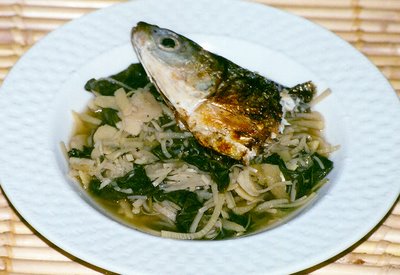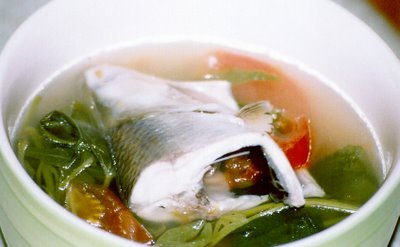
We went crazy over coconuts last February for Lasang Pinoy!
As an event-ender, here is the round-up of entries for LP 24: Loco Over Coco : a sumptuous buffet of coconut-based dishes. We have a complete array of creations, from drinks, to traditional and inspired dishes, to fabulous desserts.
But before we take our fill, let us first, as an ice-breaker, get into a discussion about coconuts, which may be a strand of our DNA, according to first-time LP participant Kathleen, of Kathleenbell.com, Massachusetts, USA.
How about turning on Da Coconut Nut Song for our background music? Courtesy of our friends Maricar and Grace, also first-time LP contributors and who have previously done a whole series on coconuts at Filipina Soul, USA.
Then let’s take a tour of our very own Coconut Palace, which highlights the ingenious ways we can use the tree of life, with our tour guide Bursky, of At Wit’s End, Manila.
Ready for a toast to the coconut? Cheers!

Lambanog with Guava Juice
Paoix, One Filipino Dish A Week, NYC, USA
Let’s warm up then to the buffet. For starters, we have bread and soup.

Pan de Coco
Dhanggit, Dhanggit's Kitchen, Provence, France

Corn & Crab Soup
Gay, A Scientist in the Kitchen
Followed by two incredible salads, both by Marketman, of Market Manila, Manila.

Ubod and Parmesan Salad

Ubod Ensalada
Hope you didn’t fill yourselves to bursting yet, because we have just arrived to the main entrees. And first in line, no less, is the famous fiery dish, Bicol Express, with accompanying Laing. Both dishes in two variants!

Bicol Express
Franco, Mariko, Monchu, Table for Three, Please, Manila

Bicol Express
Robert, Filipino Food Lovers, Missouri, USA

Laing
Joey, 80 Breakfasts, Manila

Chard Laing
JMom, Cooked From The Heart, USA
Don’t like it hot? Try chopsuey with coconut meat.

Pinoy Buko Chopsuey
Ut-man, Overseas Pinoy Cooking, Abu Dhabi, UAE
Then we have seafood in coconut milk.

Catfish in Coconut Milk
JMom, Cooked From The Heart, USA

Shrimps in Coconut Milk and Tomato Sauce/Coconut Story of My Life
Mira, Random Thoughts, Mira's Web Journal, A Moment to Exhale, USA

Tuna in Coconut Cream
Shai Coggins, Creative Geek Living, Australia

Kona Kampachi With Coconut, Apples, Ginger and Basil
Cia, Writing With My Mouth Full

Ginataang Alimango
Anneski, Kitchen Conjugations, Philippines
Hope you left enough room for dessert. For we have incredibly marvelous ones!

Buko Halo
Grace, Kitchen Journal, Kuala Lumpur, Malaysia

Bucayo Squares, Almond BucaJoy
Oggi, I Can Do That!, VA, USA

Maja Blanca
Cooking with the Fruit of Life
Maricar, Grace, Filipina Soul, USA

Coconut Custard (Leche Flan with Coconut Milk)
Sassy Lawyer, Pinoy Cook, Manila

Favorite Ginataan
Nini, Pan de Panda, Manila

German Chocolate Cake
Simple Pleasures, Sweet Tooth , Manila

Tropical Bombe
Manggy, No Special Effects, Manila

Guintaan - a warm Pinoy dessert for the cool HongKong winter
Ragamuffin Girl, Food Frenzy, Hong Kong

Mini Coco Pies
13 & 1 Ways to Enjoy Coconut
Anatomy of a Disaster
Em Dy (first to submit, congrats!), Pulse, Manila

Buko Custard Pie
Babette (Kusinera sa Amerika), Not Another Blog, USA

Pastillas, my contribution to this month's Lasang Pinoy.
And that ends our amazing smorgasbord, hope it didn’t leave anyone wanting!
It had been an honor hosting this event and rounding up all your entries. My hats off to all of you, and as they say in Pinoy, thanks a lot, coconut!
As an event-ender, here is the round-up of entries for LP 24: Loco Over Coco : a sumptuous buffet of coconut-based dishes. We have a complete array of creations, from drinks, to traditional and inspired dishes, to fabulous desserts.
But before we take our fill, let us first, as an ice-breaker, get into a discussion about coconuts, which may be a strand of our DNA, according to first-time LP participant Kathleen, of Kathleenbell.com, Massachusetts, USA.
How about turning on Da Coconut Nut Song for our background music? Courtesy of our friends Maricar and Grace, also first-time LP contributors and who have previously done a whole series on coconuts at Filipina Soul, USA.
Then let’s take a tour of our very own Coconut Palace, which highlights the ingenious ways we can use the tree of life, with our tour guide Bursky, of At Wit’s End, Manila.
Ready for a toast to the coconut? Cheers!

Lambanog with Guava Juice
Paoix, One Filipino Dish A Week, NYC, USA
Let’s warm up then to the buffet. For starters, we have bread and soup.

Pan de Coco
Dhanggit, Dhanggit's Kitchen, Provence, France

Corn & Crab Soup
Gay, A Scientist in the Kitchen
Followed by two incredible salads, both by Marketman, of Market Manila, Manila.

Ubod and Parmesan Salad

Ubod Ensalada
Hope you didn’t fill yourselves to bursting yet, because we have just arrived to the main entrees. And first in line, no less, is the famous fiery dish, Bicol Express, with accompanying Laing. Both dishes in two variants!

Bicol Express
Franco, Mariko, Monchu, Table for Three, Please, Manila

Bicol Express
Robert, Filipino Food Lovers, Missouri, USA

Laing
Joey, 80 Breakfasts, Manila

Chard Laing
JMom, Cooked From The Heart, USA
Don’t like it hot? Try chopsuey with coconut meat.

Pinoy Buko Chopsuey
Ut-man, Overseas Pinoy Cooking, Abu Dhabi, UAE
Then we have seafood in coconut milk.

Catfish in Coconut Milk
JMom, Cooked From The Heart, USA

Shrimps in Coconut Milk and Tomato Sauce/Coconut Story of My Life
Mira, Random Thoughts, Mira's Web Journal, A Moment to Exhale, USA

Tuna in Coconut Cream
Shai Coggins, Creative Geek Living, Australia

Kona Kampachi With Coconut, Apples, Ginger and Basil
Cia, Writing With My Mouth Full

Ginataang Alimango
Anneski, Kitchen Conjugations, Philippines
Hope you left enough room for dessert. For we have incredibly marvelous ones!

Buko Halo
Grace, Kitchen Journal, Kuala Lumpur, Malaysia

Bucayo Squares, Almond BucaJoy
Oggi, I Can Do That!, VA, USA

Maja Blanca
Cooking with the Fruit of Life
Maricar, Grace, Filipina Soul, USA

Coconut Custard (Leche Flan with Coconut Milk)
Sassy Lawyer, Pinoy Cook, Manila

Favorite Ginataan
Nini, Pan de Panda, Manila

German Chocolate Cake
Simple Pleasures, Sweet Tooth , Manila

Tropical Bombe
Manggy, No Special Effects, Manila

Guintaan - a warm Pinoy dessert for the cool HongKong winter
Ragamuffin Girl, Food Frenzy, Hong Kong

Mini Coco Pies
13 & 1 Ways to Enjoy Coconut
Anatomy of a Disaster
Em Dy (first to submit, congrats!), Pulse, Manila

Buko Custard Pie
Babette (Kusinera sa Amerika), Not Another Blog, USA

Pastillas, my contribution to this month's Lasang Pinoy.
And that ends our amazing smorgasbord, hope it didn’t leave anyone wanting!
It had been an honor hosting this event and rounding up all your entries. My hats off to all of you, and as they say in Pinoy, thanks a lot, coconut!






















